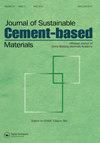硅酸盐水泥碳化硬化反应:养护温度的影响
IF 4.2
3区 工程技术
Q1 CONSTRUCTION & BUILDING TECHNOLOGY
Journal of Sustainable Cement-Based Materials
Pub Date : 2023-01-17
DOI:10.1080/21650373.2022.2163432
引用次数: 2
摘要
新浇混凝土的CO2养护是建筑行业中允许直接固碳的解决方案之一。此外,与传统的水化固化相比,它提高了早期的力学性能。碳酸化养护温度对硅酸盐水泥硬化过程中的两个反应都有显著影响:碳酸化和水化。这两种反应都随着温度的升高而加速,同时形成的产物和产生的微观结构发生了改变。较高的固化温度促进了硅胶和C-S-H相的沉淀,降低了Ca/Si比。此外,氧化铝和硫酸盐在反应产物中的分布是不同的。碳化养护温度对碳化养护后水泥浆体水化有明显影响。与在较低温度下固化的样品相比,高固化温度导致基质致密化,这限制了进一步的反应进展。在后水化过程中,缺钙体系转变为具有较高Ca/Si的C-S-H相,并最终转变为磷铝石。本文章由计算机程序翻译,如有差异,请以英文原文为准。
Reactions involved in carbonation hardening of Portland cement: effect of curing temperature
CO2 curing of fresh concrete is one of the solutions allowing direct carbon sequestration within the construction industry. Additionally, it enhances the early mechanical performance when comparing to traditional hydration curing. Temperature of carbonation curing has pronounced impact on both reactions involved in hardening of Portland cement: carbonation and hydration. Both reactions are accelerated with rising temperature, while the formed products and resulting microstructure are altered. Higher curing temperature promotes the precipitation of silica gel and C-S-H phase with reduced Ca/Si ratio. Furthermore, alumina and sulfate distributions among the reaction products are different. Temperature of carbonation curing has a distinct impact on the cement paste hydration after carbonation curing. The high curing temperature results in a densification of the matrix which limits further reaction progress, compared to the samples cured at lower temperatures. During the post hydration, calcium deficient system changes into C-S-H phase with higher Ca/Si and eventually portlandite.
求助全文
通过发布文献求助,成功后即可免费获取论文全文。
去求助
来源期刊
CiteScore
6.60
自引率
15.90%
发文量
71
期刊介绍:
The Journal of Sustainable Cement-Based Materials aims to publish theoretical and applied researches on materials, products and structures that incorporate cement. The journal is a forum for discussion of research on manufacture, hydration and performance of cement-based materials; novel experimental techniques; the latest analytical and modelling methods; the examination and the diagnosis of real cement and concrete structures; and the potential for improved cement-based materials. The journal welcomes original research papers, major reviews, rapid communications and selected conference papers. The Journal of Sustainable Cement-Based Materials covers a wide range of topics within its subject category, including but are not limited to: • raw materials and manufacture of cement • mixing, rheology and hydration • admixtures • structural characteristics and performance of cement-based materials • characterisation techniques and modeling • use of fibre in cement based-materials • degradation and repair of cement-based materials • novel testing techniques and applications • waste management

 求助内容:
求助内容: 应助结果提醒方式:
应助结果提醒方式:


